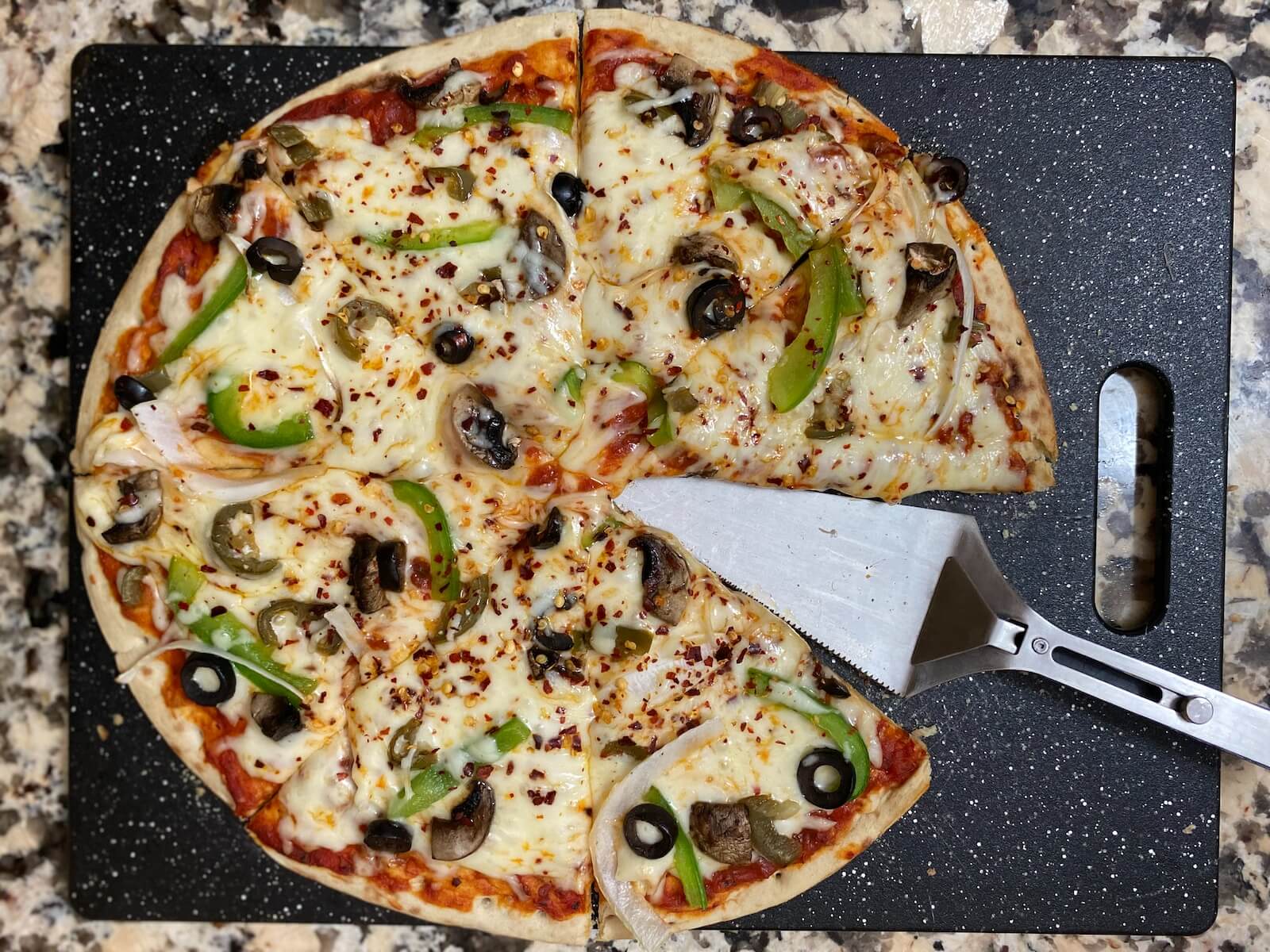Making pizza at home is always a fun family experience and can be a better option than your usual takeout. There’s no need to feel like you’re eating something unhealthy and greasy when chowing down on homemade pizza. In fact, it can be very healthy for you. With the toppings you decide to put on your pie, especially the cruciferous vegetable kind, you can actually boost your brain health. That’s why StudyFinds has compiled a list of some of the top homemade pizza recipes from the experts themselves to help improve your mental acumen.
One tasty topping to add to your homemade pizza is mushrooms, which may help sharpen your brainpower. A recent study finds that seniors who consume two portions of mushrooms per week are half as likely to develop mild cognitive impairment (MCI). MCI is considered a stage of cognitive decline not as serious as Alzheimer’s disease or dementia, but sufferers still find themselves struggling to a degree with memory, attention, and other executive functions. As many as one in five seniors battle MCI, according to the Alzheimer’s Association. Researchers from the National University of Singapore (NUS) say that two portions of mushrooms is equal to about a half a plate or 300 grams, though even enjoying one portion a week still provides brain benefits.
For those who are pregnant, topping your homemade pizza with cruciferous vegetables is not only healthy for you, but also your baby. A recent study shows that eating a choline-heavy diet, including cruciferous veggies like broccoli, during pregnancy can boost the child’s attention span. The study compared 7-year-old children from mothers who ate a diet with normal levels of choline and another group from mothers eating twice the typical amount. The results suggest that recommended choline levels in dietary guidelines don’t fully meet the needs of a mother and her unborn child. Moreover, researchers say most prenatal vitamins don’t contain choline and 90 percent of pregnant women don’t even meet the recommended amounts in their daily diet.
Not only can adding cruciferous veggies to your pizza help boost your brain health, but it can also enhance a person’s blood vessel health. Researchers at Edith Cowan University in Australia say eating more cruciferous vegetables — such as broccoli, Brussels sprouts, and cauliflower — could be the key to better blood vessel health. In the study, researchers looked at data from 684 women in Western Australia who were recruited in 1998. Results show that women who eat more than 45 grams of cruciferous veggies each day — equal to about ¼ cup of steamed broccoli or ½ cup raw cabbage — are 46 percent less likely to have calcium build-up on their aorta.
Maybe the best thing about making a homemade pizza is you don’t have to worry about pigging out on it! A study involving pizza finds people can eat much more than what normally makes them feel “full” without causing health problems. The University of Bath says young men are able to devour twice as much pizza when they push themselves. For some in the study of 22-37 year-olds, this means chowing down two-and-a-half large pies in one meal!
Are you ready to make some healthy and scrumptious homemade pizza? StudyFinds has put together a list of just of the best, expert-recommended homemade pizza recipes that can help boost brain health. Did we miss one of your favorites? Let us know in the comments below!

The List: Best Homemade Pizza Recipes For Brain Health
1. Homemade White Pizza With Broccoli From It’s A Veg World After All
“This delicious white pizza with broccoli recipe features steamed broccoli tossed in olive oil and red pepper flakes, ricotta cheese mixed with garlic, mozzarella, and fresh lemon zest. It’s a simple vegetarian meal that the whole family will love!” writes It’s A Veg World After All.
Key brain health ingredients:
- Broccoli florets
- Garlic cloves
- Ricotta cheese
- Olive oil
- Red pepper flakes
“Every slice is loaded with flavor and texture,” writes Lizzie Streit. “Crunchy broccoli and creamy ricotta, punctuated with red pepper flakes, garlic, and lemon zest, sit on top of a crispy crust. Are you drooling yet?”
Click here for the full recipe.
2. Cauliflower Pizza Crust Recipe From Delish
“Possibly our favorite use of cauliflower as a culinary master of disguise is in pizza crust. It might sound crazy but it can be a delicious and healthy alternative to the classic. In this easy, gluten-free pizza recipe, you’re basically making cauliflower rice as base the base for your crust,” writes Delish.
Key brain health ingredients:
- large head cauliflower
- grape or cherry tomatoes
- garlic
- large egg
“Keep things simple with fresh tomatoes and basil, or get creative,” says Lindsay Funston. “Sautéed peppers and onions, sliced olives, cooked and crumbled sausage. Ham and pineapple? Why not! And pepperoni is always a good call—and you can even buy a vegan version if someone at your table doesn’t eat meat.”
Click here for the full recipe.
3. Mushroom Pizza With Fresh Herbs From A Couple Cooks
“Now, what kind of mushrooms go on pizza? Literally any kind of fresh mushroom will work here, but not canned,” notes A Couple Cooks.
Key brain health ingredients:
- mushrooms
- goat cheese
- olive oil
- lemon juice
“This mushroom pizza recipe uses a handful of fresh herbs: and it’s so much more fun to grow them yourself!” write Sonja and Alex Overhiser. “We grow herbs all summer long, and it’s one of the most satisfying things to run out to the garden and harvest a few herbs. You don’t even need garden space: you can just grow herbs in pots as long as you have a sunny ledge! And adding herbs to your cooking is a healthy flavor addition, without adding calories.”
Click here for the full recipe.
4. Brussels Sprouts Pizza With Balsamic Red Onions From Cookie + Kate
“This pizza may not be for everyone, but I’m a fan. Boldly flavored, semi-caramelized onions with reduced balsamic vinegar, topped with mozzarella and Brussels sprouts (sliced two ways for maximum crispiness and texture) and a sprinkle of Parmesan for good measure,” says Cookie + Kate.
Key brain health ingredients:
- Brussels sprouts
- balsamic red onions
- red pepper flakes
- olive oil
“After several prototypes, including red onions on top, pesto on bottom and a failure of a creamy spinach sauce, it finally occurred to me to use balsamic, caramelized red onions as the base. That’s the ticket!”
Click here for the full recipe.
5. Supreme Vegetarian Pizza With Mozzarella And Feta From Good Life Eats
“This Vegetarian Pizza is loaded with fresh vegetables like bell peppers, mushrooms, tomatoes, onions, and more! Pizza with veggies is a great way to use up your favorite vegetables. The mixture of salty feta and creamy mozzarella really make this easy veggie pizza recipe,” writes Good Life Eats.
Key brain health ingredients:
- Black Olives
- Bell Pepper
- Cherry Tomatoes
- Mushroooms
- Onions
“We had this Supreme Vegetarian Pizza with Mozzarella and Feta for our Friday Night Pizza a few weeks ago. It was so good,” says Katie Kick. “I’ve quickly become a big fan of pizza on the grill and pizza night in general. I love the flavor of grilled pizza. It cooks so fast and the crust gets that great chewy/crunchy texture.”
Click here for the full recipe.
Tips For Homemade Pizza Planning
If you decide to go down the homemade pizza route, it’s important to plan ahead. Do you know how many people you want to serve? How much time will you have for preparation and cooking? Which ingredients do you need to go pick up from the grocery store? What recipe do you plan on following and did you read through it thoroughly first? These are key questions you’ll need to consider first.
Once you’re ready to go, there are plenty of other considerations to keep in mind to ensure the final product turns into the pie you dreamed of at the start. Here are 9 suggestions for your homemade pizza journey:
- Use high-quality ingredients. This will make a big difference in the taste and texture of your pizza. Start with a good quality pizza dough, either store-bought or homemade. If you’re making your own, use bread flour and high-gluten flour for a chewier crust.
- Don’t overwork the dough. Kneading the dough helps to develop the gluten, but overworking it can make the dough tough. Knead the dough until it is smooth and elastic, but not so much that it becomes springy.
- Let the dough rise in a warm place. This will help the gluten to relax and make the dough easier to stretch. Let the dough rise for at least 1 hour, or until it has doubled in size.
- Preheat your oven and cooking surface. A hot oven is essential for a crispy crust. Preheat your oven to 500 degrees Fahrenheit (260 degrees Celsius). If you have a pizza stone, preheat it in the oven for at least 30 minutes. Otherwise, you can use a baking sheet or cast iron skillet.
- Stretch the dough thinly. The thinner the dough, the crispier the crust will be. Use your hands or a rolling pin to stretch the dough into a 12-inch circle.
- Add your toppings sparingly. Too many toppings can make the pizza soggy. Add a thin layer of sauce and cheese, and then top with your favorite toppings. If you are using a lot of juicy toppings, such as mushrooms or tomatoes, you can precook them before adding them to the pizza. This will help to prevent the aforementioned sogginess.
- Bake the pizza for 10-12 minutes, or until the crust is golden brown and the cheese is melted and bubbly.
- If you want a crispier crust, you can pre-bake it before adding the toppings. To do this, simply bake the crust alone for 5-7 minutes, or until it is starting to brown. Then, remove it from the oven, add your toppings, and bake until the pizza is done.
- Use a pizza peel to transfer the pizza from the counter to the oven. This will help to prevent the pizza from sticking to the pan.
